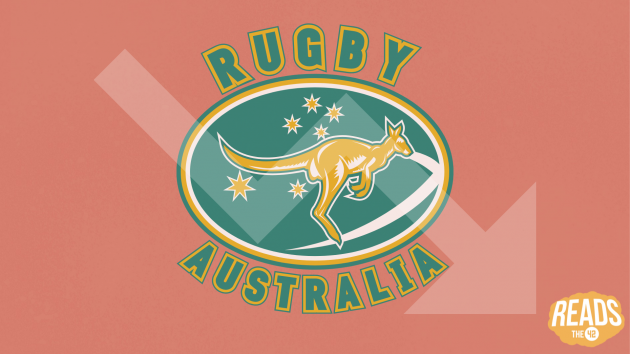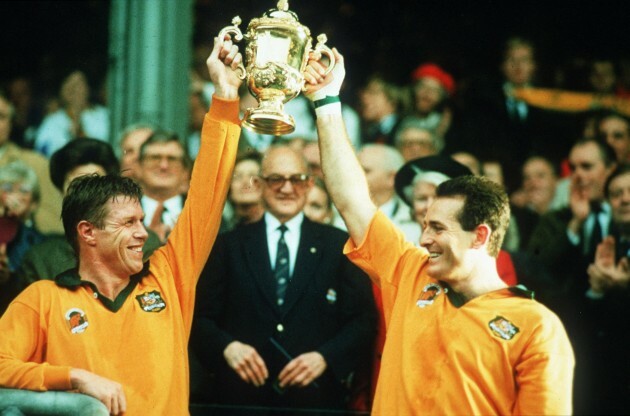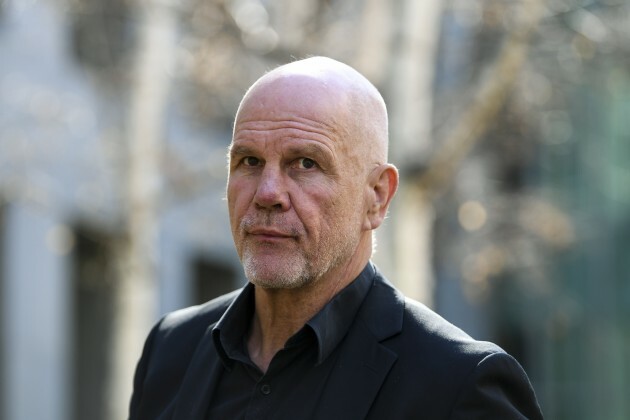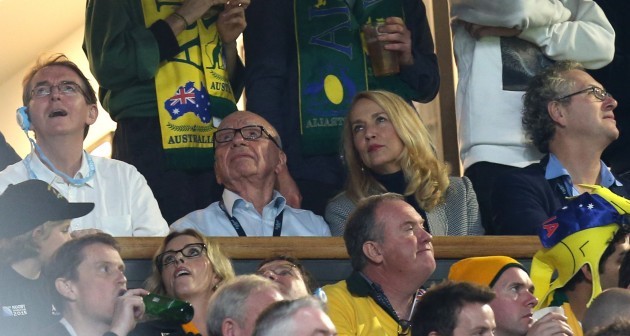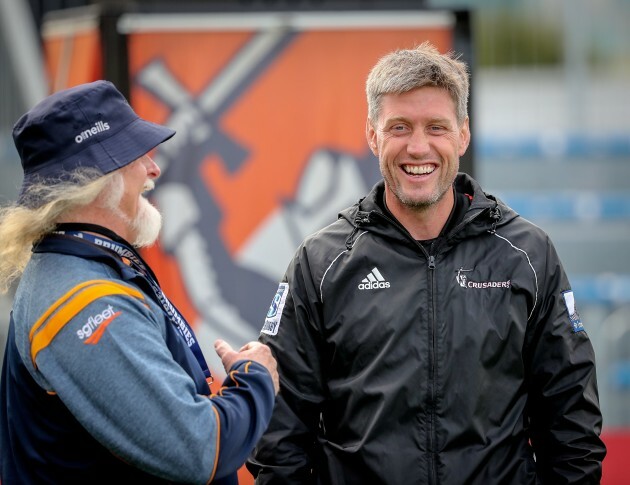IT IS ONE of the most drastic declines in global sport. In 2003, Rugby World Cup hosts and finalists Australia were ranked second in the world. Two years previous the Lions came and were conquered. Two of the last four Web Ellis trophies bore their name.
Every possible metric screamed strength. Attendances were booming, a world record 107,042 witnessed the 1999 Bledisloe Cup win over New Zealand. Super Rugby crowds and junior participation continued to rise.
Despite the disappointment around Johnny Wilkinson’s last gasp drop goal, the top brass stood at the top of the mountain and looked down on a body that was in rude health. Their biggest worry was what to do with the tournament surplus, estimated to total $44.5 million.
This was the calm before the storm; they had no idea what was to come.
Fast forward to last month. Rugby Australia chairman Hamish McLennan admitted the body were “shaken to its core” by last year’s chaos. There were serious conversations about reverting to amateur status.
- For more great storytelling and analysis from our award-winning journalists, join the club at The42 Membership today. Click here to find out more >
“It was a real possibility. It wasn’t just idle talk. But we got through it and there’s light at the end of the tunnel. We knew it was going to be brutal, so it’s not really a surprise. I’m proud of the fact that the team here has kept the game alive and professional,” he declared.
Former Wallaby and current journalist Peter FitzSimons is more frank in his assessment.
“Is it has been a very grim 18 years. Two utterly dire decades. In 2020, the game was on the bones of its arse.”
The organisation is still surveying the wreckage. Australia have fallen to seventh in the world, their worst standing ever. In the bush and in the suburbs, clubs continue to fold. The pandemic did not create fault lines, it widened existing ones.
The net deficit for 2020 was $27.1 million. They also needed loans from World Rugby ($13.8m) and HSBC ($6.9m) in order to stay afloat.
Australians often refer to rugby union as the game they play in heaven. Now they occupy hell.
How did this happen? And what, if anything, can Ireland learn from it?
***
“We have lost our way and our culture in this country. We don’t have an Australian rugby identity anymore. We are not revered or respected as leaders as we once were. It’s so disappointing for not only me, but all the fans and staunch supporters who remember when Australian rugby dominated the world.”
This is how legend David Campese summarised the current state of affairs. He was speaking on The Breakdown, a comprehensive six-part podcast that explores how the code with all the money went broke. Jessica Halloran is chief sportswriter at the Australian and oversaw the project.
It is an extensive deep dive featuring interviews with numerous former players, coaches, prime ministers, chair people and grassroots volunteers. Only two individuals declined interview requests, former chief executives Raelene Castle and Bill Pulver.
The series is revealing and stark. Halloran knew the sport had issues, still the extent of what she discovered stunned her.
“I have been a sports journalist for 20 years and I have never seen a sport in a mess like rugby.”
“I was so surprised. I was raised in Victoria. The code was having a massive breakthrough back in the ’80s and 9’0s. The Wallaby’s were everything. People like David Campese. But then you also see the way the AFL do it and how their legends are respected while David Campese spoke about how he couldn’t get a job here. That had me raising my eyebrows I had to say.
“Nick Farr-Jones walked away in 2016 because he was so sick of the corporate wastage. You have greats being left out in the cold; you have to look at the culture.”
Campese came from a golden era that included Michael Lynagh, Phil Kearns, Jason Little and Stephen Larkham. They generated attention and adoration. A man who played alongside several of them was former Wallaby lock Peter FitzSimons.
He is now an outspoken journalist and television presenter. For him, that period was the game’s peak. Crucially, it was also the early days of professionalism.
“The absolute top was ‘99 when the Wallaby’s won the World Cup. It was similar to when we won the America’s Cup in Sailing,” he recalls longingly.
“You know the way in America they say the Dallas Cowboys are America’s team? Basically, everyone’s second favourite team. The big brand. That was the Wallaby’s in the 80s and 90s. If you looked into the crowd at Wimbledon, you would always see a Wallaby jersey. It was the symbol of Australians overseas.”
The players were valued and knew it. The time was coming to put a prize on that value. Minimal match fees and travel vouchers would no longer cut it. The sport was booming, new tournaments were flourishing.
In the midst of this mania, enter media mogul Rupert Murdoch. He spotted opportunity and struck a deal. Ten years of television rights with the rugby unions of Australia, South Africa and New Zealand. Little do he know of the brewing battle that would irreversibly change rugby.
FitzSimons charts this time in his excellent book, The Rugby War. ‘Australia’s richest man’ Kerry Packer had fought for control of rugby league. The problem was that union had sway beyond New South Wales and Queensland. It had global appeal and both tycoons wanted a slice.
In league, Packer played the role of establishment and Murdoch the rebel. That switched in union. Murdoch had the unions on side, so Packer went after the players and tried to sign them up to his own entity, World Rugby Corporation.
Eventually after a lengthy contest with many convoluted legal implications, Murdoch succeeded. The competitions would unfold via the traditional unions. The war in rugby league continued until 1997. It meant Union stars like Tim Horan and Jason Little were offered lucrative contracts to switch codes. Keeping them within the house came at a cost.
The money came from a broadcasting deal that meant it would be screened exclusively by Murdoch’s Foxtel network. An unprecedented path with seismic implications. You can’t unring a bell.
Over the next decade, priorities began to change. Now focus was predominately on the upper echelon.
For Halloran, the bedrock was abandoned. It was only a matter of time until it all began to crumble.
“The issue, everything comes back to grassroots. What has happened with rugby since 2003, the grassroots have been horribly neglected. There have been moments where money was put into the bottom of the pyramid but for the most part they have been overlooked while there is a spendathon at the top of the game.
“There is still a love for club rugby out there, but it is the front office failure to capitalise on that love and neglecting the people who buy tickets and enrol their kids in junior rugby. It is too simplistic to just look at the broadcast question.”
FitzSimons is weary. Where he lives in Sydney’s north shore is traditionally dyed-in-the-wool rugby country. Now the local schools play Aussie Rules. He has strong views about the global direction of rugby and the way the game has gone but nationally the buck stops with the utter failure to engage grassroots.
“Every sport is a pyramid. The lower base is the people who play at a local level, schools and kids. The top tier is the professional. In AFL, it is so well administered that they produce huge money and the majority of which goes into the base of the pyramid.
“The problem with rugby union over the last 20 years is that they put all their resources into the pointy end of the pyramid. Of course, the whole thing fell over.
“What that means is the development officers, a fella I knew was paid $80,000 a year to go into schools in western Sydney and spread the word about rugby union. He was axed because there was no money for that.
“David Pocock for example, our best and brightest, a wonderful player but he was given a million dollars to go on a sabbatical to Japan. He injured himself there and came back injured. A million dollars to give him a break and he got injured.
“That is insane.”
A common tale is that the decline manifested because few watched it. While it is partially true that Super Rugby weakened behind the Foxtel paywall, the reality is that this was merely one blow in a full-bodied attack. Structures, scheduling and substandard franchises all played a part.
In fact, Australia anti-siphoning rules are some of the strictest in existence. This is legislation that makes it harder for top sporting events such as the Melbourne Cup, State of Origin rugby league and the AFL grand finals to be put behind a paywall. They were introduced in 1992 as pay TV began to emerge.
It ensures free-to-air networks have the right to bid for listed events before pay-per-view broadcasters do. Included on the list is “each international test match involving the senior Australian representative team selected by the Australian Rugby Union, whether played in Australia or overseas” and “each match in the Rugby World Cup tournament.”
Before finding a solution, you need to know the problem. Within the country, there are many different and often competing narratives. For decades, Australia had one of the most concentrated media markets in the world. The previous broadcasters were Foxtel, part of the Murdoch’s News Corporation who also own the Australian, Fox Sports, the Herald Sun and the Telegraph.
The current broadcasters are Nine, who are under the same umbrella as The Sydney Morning Herald and The Age. That is why in the last week alone you will find conflicting headlines about viewership figures for the recently completed Super Rugby tournament.
Laurie Fisher is a man familiar with Ireland’s approach to broadcasting the game and the Australian way. The former Munster forwards coach is currently in the same job with the Brumbies.
As far as he is concerned, there are drawbacks from the Super Rugby approach.
“You get a few thousand now, but does it cost you down the line? Less people see it, less people support it. I know there is a tremendous tradition already over there of going to games and watching them. We don’t have the same culture in rugby union here. I like to see the game on free-to-air but the economics don’t always allow it.
“It had an effect. The longer it went on the less exposure rugby got.”
Yet, he stresses, you cannot overlook the fact it was necessary. The sport remains in a perilous state worldwide. Few organisations are actually profitable.
“They became our paymasters,” he exclaims. “Without Rupert’s money we were gone. We do not generate income. Mate, nobody does. None of the teams. Look across the world, look at England. Bar Exeter, rugby is an environment where you lose money. How do you survive?
“It is part of the game. We have taken a huge hit as Australian rugby over the past few months. Our budgets are really reduced. That is purely down to new arrangements around how the game is televised. We are totally tied to the fortunes of that.”
Speaking of tied fortunes…
One of the most important tours in the history of Irish rugby was their venture Down Under in 1994. After the disastrous New Zealand tour of 1992, assistant coach Gerry Murphy and IRFU technical director Willie Anderson were sent to Australia to look at their system.
This process continued in ’94. The Irish party studied their talent identification process, the link-up with the Australian Institute of Sport, the use of psychologists and dieticians. Tour manager Frank Sowman detailed all of this in his end-of-tour report.
On the field, NSW technical officers enlightened the likes of Eric Elwood on the use of a five-ruck pattern. Off it, Australia showed Ireland where they needed to go. The IRFU gradually took chase.
Now they have an Aussie Ruler.
In 2004, David Nucifora led the Brumbies to a Super Rugby title. Then they let him go. It emerged subsequently several players disagreed with his robust, top-down nature.
He left to become technical adviser and later head coach with the Auckland Blues before returning to Australia in the role of high-performance manager.
There he endured a contentious stint. In a piece for The Australian in 2018, former Wallaby Mark Ella described it as such:
“In 2012, former ARU chief executive John O’Neill and high-performance manager David Nucifora presented a strategic plan to centralise Australian rugby along the lines of the New Zealand model, recognising it gave the Kiwis a competitive advantage at Test and Super Rugby levels.
“To say there was push back from conservative-thinking Australian rugby stakeholders would be an understatement.”
O’Neill and Nucifora were gone shortly after. In 2014, the former hooker brought his persistent ideals and straight-talking manner to Ireland. It was a five-year deal that was extended for another three in 2019.
Nucifora conducted a series of interviews with Australian press during Ireland’s summer tour of 2018. In them, he touched on a host of topics including that unsuccessful stint in Australia, his relationship with former coach Robbie Deans and the World Cup chances for Joe Schmidt’s outfit.
He also hailed the Irish system and the success it generated. At the time, Ireland were Six Nations Champions. They would close out the year with a second win in two years over New Zealand and ranked first in the world.
“My role oversees all the national team and programs but as part of that, the four provinces answer through to the central body. We contract the CEOs, we contract the head coaches, we contract the head of strength and conditioning, the physiotherapists, the head of academies and the elite player development staff that work within that,” he told Rugby.com.au.
“We have built on that, and we have invested a lot into the pathways. So we employ the nutritionists and analysts and strength and conditioners, who work off the academies. Then we make sure all of those people, who might be wearing Munster or Leinster colours but are all IRFU employers, use a strategy that is consistent so everyone is on the same page. That’s the strength of the model.”
Managing players’ careers and fending off foreign interest. The Wallabies could only dream of such structure. At the same time, they were enduring a nightmare. In 2018, they won four of 13 games. Domestically there was consternation as Western Force were excluded from Super Rugby.
Nucifora drummed home the benefits of the Irish arrangement.
“But more importantly, players want to win things and at the moment the system is helping to win things; both provincially and internationally,” he said.
“The good thing about our system, people say ‘oh its hard on the provinces.’ But I think this year is a really good example that you can do both.”
The following October, Irish rugby launched their five-year strategic plan. Since then, they have not finished higher than third in the Six Nations. Provinces have faltered in Europe and the Pro14 continues to underwhelm.
It begs the question; the system is good but could it be better?
South African native Brendon Shields is the man who operates Rugbycology, a rugby analytics website that focuses on predictive analysis. He currently lives in Queensland. Before that, he spent some time in Ireland. He could not help but be struck by certain similarities.
“I went to Dublin in 2014 and was invited to do skills tests on one of the metro squads in Leinster. Basically, a lot of kids come into rugby union from a Gaelic background, from state schools.
“They wanted to see from a skill and technique base how far off are these players. Jack Augier who is with Connacht now, he was one of the generation that I measured.
“First-hand, I got to see the skillset of the boys who came from Gaelic. It is obviously very different. More explosive, their feet are more elusive I would say. They are the kinds of skills used in GAA. More evasion-based; less collision-based than union would be. Different forms of catching, all that.
“I was really disappointed to discover the skills in the mainstream schools of Ireland was in no way unique to the South African model I would have been used to. I then realised why, learning more about Irish rugby and seeing how private schools drive the game there. Then you look to the second sport there. Your secondary sport has a huge effect on rugby skillset.
“Say rugby is your main sport in Blackrock college or whatever, your second sport is important. How that influences your skillset is relevant. Look at New Zealand, Australia, their secondary skillset is cricket because of that English history.
“Coming to Australia, it was the same thing immediately. How rugby is structed in schools here is the same. Private schools dominate. They have the big competitions, quite exclusive, very rarely would play schools in leagues lower than them. Sydney’s GPS competitions, they don’t regularly play state schools or clubs.
“They keep it between themselves. The problem is that in terms of developing a skillset or different influences, there is no infiltration whatsoever.”
Shields grew up in a South Africa breaking free of apartheid. There the door was forced open and black South Africans flooded into the system. Not only did it broaden the playing pool. A new style and way of thinking invigorated the game.
This is an important example in the context of Ireland. While a trickle of underage GAA players have progressed to professional rugby, it could be a flood. Moreover, they are still developed by traditional schools and academies with traditional thinking.
“I dealt with St Michaels in Dublin,” Shields says.
“They model themselves on Exeter. Exeter have looked to what the Springboks did in the World Cup. If you could tap into that new ground, it would be a unique edge. I found it funny but coming to Australia, it is exactly the same.
“We do things the same. The way New Zealand catch the ball is the way we all want to. Yet here down the road you will see an AFL player do amazing things in the air and there is no infiltration.
“That is the most striking thing. It is too insular. No real creativity to think outside of the box.”
Both Ireland and Australia have a huge reliance on private schools to produce players. The upside is a steady stream of ready athletes to filter through to Leinster and other academies. The drawback can be found in the fact the game is propped up by a narrow base.
A resolution lies with the grassroots. Yet the issues here have become increasingly apparent recently. Bernard Jackman is someone who harbours fears that Irish rugby could go the same way as Australia unless certain things change.
Speaking on The42′s Rugby Weekly podcast last month, he outlined his concerns for the game in Ireland.
“We’re not a million miles from going into a bit of a crisis in Irish rugby. Honestly, we’re not. Our core competition, the Pro14, isn’t healthy at the moment — we’re hoping the Rainbow Cup gets better. The international team, last three years, were third in the Six Nations: we’re not challenging for World Cups, let’s be honest. And underneath, the people in the domestic game are fatigued, they’re lacking energy, they’re lacking the feeling of connection to the professional game.
“Suddenly, then, attendances drop, sponsorship drops, and the professional game doesn’t have the money it has now, and then you’ve got to try and dig yourself out of a hole.”
Australia have struggled in this regard as well. Over and over again, Jessica Halloran heard from disenfranchised and fatigued people within club rugby. “It is catastrophic,” proclaimed the secretary of one Queensland club.
Breaking new ground is crucial. She points to her conversation with Teki Tuipulotu, President of the Blacktown Scorpions, who spoke about a lack of hospitality and engagement from rugby union.
“It is all well and good to sing the national anthem in Eora language and English but where are the indigenous players?
“Beale was amazing, the Ella brothers were incredible, but we have a remarkable, indigenous sporting talent. It is right there. There is a huge pacific community here.
“Teki said in the podcast he constantly gets rugby league scouts at his games; a nursery is right there. He also felt he was discriminated against in terms of coaching opportunities. They need to do more.”
Things are starting to change and a template is gently emerging. The Queensland Reds squad that won Super Rugby AU last week has a heavy local presence. The club also launched a ‘Reds to Regions’ tour last year. Players, coaches and staff travelled around regional Queensland on a multiday tour, visiting supporters and underage clubs.
Brendan Shields has been watching this unfold. As he reflects on Ireland, he would love to see them embrace their ample raw materials and use that to mould their own, distinctive system.
“The Irish from my measurements were on average six percent more skilled in terms of technique and ability to execute compared to Australians and South Africans. There is a natural skill ability with ball in hand, but it isn’t nurtured.
“The way certain provinces played historically, Munster or the way Ireland were successful, there was an element of knuckling down. That is anecdotal by the way. Ireland seems to have a conservative way of thinking around rugby.
“Their natural skillset and the potential in other areas of the country mean they actually don’t have to think that way.”
As for the future? Rugby Australia are now targeting private equity. That is a blight on those who mismanaged the code so far. Jessica Halloran is optimistic if the reported interest from billionaire Andrew Forrest comes to fruition. He will only invest if there is constitutional overhaul and that, she emphasises, is a must.
Righting a ship with so many holes is no easy task. The extent of it is best illustrated by the number of tenants that are currently broken; everything from grassroots to league structures and fan engagement needs to improve. It also demonstrates just how quickly things can unravel when there is slack management. That lesson should not be ignored.
Because in reality, Australia’s decline is not just a sad story. It’s a warning.
The42 Rugby Weekly / SoundCloud
Bernard Jackman, Garry Doyle and Gavan Casey discuss the interpros and, inspired by new Ospreys signing Jack Regan, the need for Irish rugby to expand its methods for producing talent.
- For more great storytelling and analysis from our award-winning journalists, join the club at The42 Membership today. Click here to find out more >
